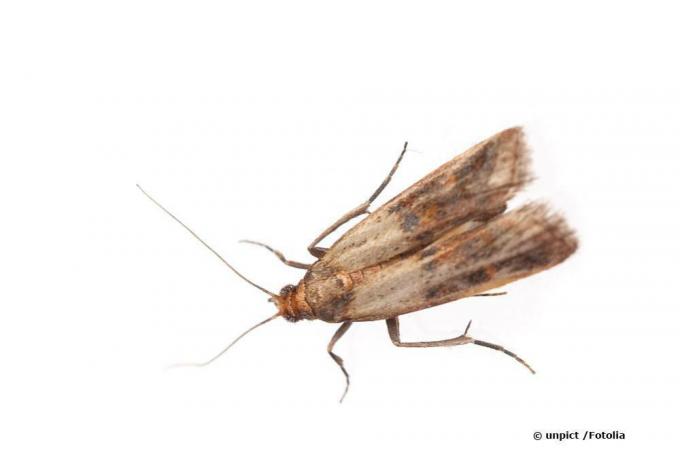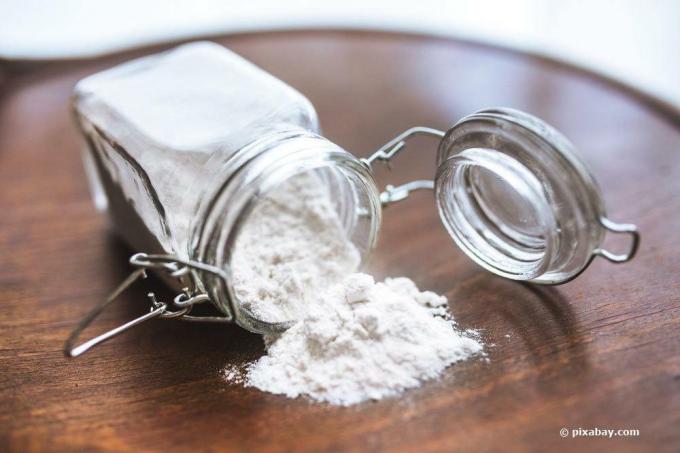
table of contents
- The danger of moth maggots
- Rapid increase
- Moth maggots on the kitchen ceiling
- causes
- Fighting food maggots
- Food disposal
- Moth maggots caught alive
- Eggs control
- Vinegar and salt
- pepper spray
- Control with the help of beneficial insects
If small, light-colored maggots are recognized on the ceiling in the kitchen, it is usually the so-called larva of the food moth. There are various reasons why it should be in your kitchen of all places. Not only is their emergence disgusting to many, but it can also be harmful to health. It is important that moth maggots are fought as quickly as possible. You can find out which effective control methods are available below.
The danger of moth maggots
As flying moths, the animals do little to no serious damage to your food. Rather, it is their offspring that they lay as eggs and as Moth maggots can become a health hazard. You are responsible for damage to food.
There is contamination caused by the droppings and the web of moth maggots. Fungi as well as mites are attracted and cause further contamination of food. These are already unusable for consumption by the remains of the moth maggots.
Because the moth larvae bite through a myriad of materials, an infestation can contaminate large food supplies. Cardboard and soft plastic materials are not a problem for them. They get through the smallest slots in lids. Since only disposal is advisable here, it is not uncommon for a lot of money to end up in the trash.

Rapid increase
Moth maggots can quickly cause a whole maggot plague. If they have developed into adult moths after around five to six weeks, they can lay between 50 and 500 eggs. After that, they die between ten and 14 days of age. New maggots emerge from the eggs after about three to five days. These are then ready for reproduction again in another five to six weeks as adult moths, so that without rigorous control of the reproductive cycle, thousands of moth maggots will ceaselessly arise can. The curious thing is that these can have different colors.
Moth maggots on the kitchen ceiling
Admittedly, the kitchen ceiling is certainly an unusual place for moths or their offspring. But that doesn't prevent them from crawling along the ceiling. There can be various reasons why they are to be found there in the kitchen of all places.
causes
Attracted by light
Because adult moths are attracted to light in the dark, the possibility of that it gets into the kitchen when it is aired at dusk and when the ceiling lights are on are. If the lighting on the ceiling is made of natural materials, moths can lay their eggs there. Once the maggots have developed, they leave their "camp" and move across the ceiling towards food supplies to satisfy their hunger.
Got through window slits or openings
Immediately after the maggot development stage, the animals are very hungry. In search of food they get into the kitchen through the smallest slits and openings in the brickwork, on windows and doors. They do not shy away from long journeys. The ceiling offers the possibility to reach all areas in the kitchen almost safely.
Through contaminated food from the trade
It happens rarely, but it does happen that you buy food, or even pet food, that already has eggs or moth maggots in it. This can be dry dog food, flour, oatmeal packs or nuts and chocolate, to name just a few examples.
If they got into the kitchen or pantry in this way, they can eat their way out through the packaging and go “wandering” to other sources of food. As already mentioned, they do not shy away from long walks or detours, so that they can often be seen on the ceiling in the kitchen. But also cracks on / in worktops or on the baseboards are often used for the move. They seldom crawl across the floor.
tip: Moth maggots on the kitchen ceiling can be a sign of an incipient infestation as well as an already existing one. As a precaution, you should always assume the latter and not allow time to pass unnecessarily in order to tackle the pest control.

Fighting food maggots
If you have discovered a moth maggot on the ceiling, you must of course dispose of it. This can be done with household waste, but it should be taken into account that this does not prevent living maggots from developing and laying eggs. Especially in garbage cans they often find a suitable environment to survive and multiply. They can also get out of it quickly. Under certain circumstances you will meet the same maggot again after a short time or it will gain access to the egg tray again as a moth. Therefore, every control measure should go hand in hand with the goal of killing. Suction is also only suitable if the killing takes place. Otherwise they will eat their way through the vacuum cleaner bags or simply crawl back to the exit as soon as the vacuum cleaner is switched off.
Food disposal
In general, when moth larvae are discovered, all food packaging should be checked for the slightest damage immediately. If there is the slightest suspicion that moth maggots are or have been found in them, they must be disposed of immediately. Do not forget that the pests can get inside even through the smallest leaks in lids and through soft plastic containers. It is optimal that they dispose of the food supplies preferred by maggots from the kitchen cabinets and shelves. These include:
- flour
- rice
- Food starch and sauce binders
- nuts
- legumes
- Chocolates and chocolate spreads
- Pasta
- Cereals
- Biscuits and the like
- Dry spices
Moth maggots caught alive
Before you dispose of (possibly) contaminated food in the household rubbish, killing is necessary for effective control and to prevent new pest infestation. This also applies to animals that have been sucked up or otherwise caught alive.
The easiest way to do this is to put the sorted out food, packaging material and the vacuum cleaner bag into the freezer place. Of course, it should not contain any untainted food. The freezer should remain in place for a period of three days. After that, the pests are guaranteed to freeze to death and can safely end up in the household rubbish.
Eggs control
Moth eggs are usually invisible to the naked eye because they are extremely small. Effective and, above all, sustainable control also includes the destruction of the eggs. To do this, proceed as follows:
- Mix a few tablespoons of vinegar essence with one liter of water
- Wipe down all of the shelves and cabinets with the solution
- For corners and hard-to-reach places, we recommend using a spray bottle into which the vinegar-water mixture is poured
- It is important that you proceed carefully and, if possible, leave nothing out
- Above all, don't forget lamps or decorative items made from natural materials. Eggs are also often laid here
- The eggs are reliably destroyed by the mixture
- In addition, the vinegar ensures simultaneous disinfection.
Vinegar and salt
You can combat it very effectively with a mixture of water with vinegar and salt or pepper. When preparing the water-vinegar mixture, proceed exactly as described above under "Eggs control". Add only one to two tablespoons of salt. Then the mixture is poured into a spray bottle and the maggots sprayed on the ceiling well. After a few minutes, they fall down dead and can easily be vacuumed up or swept up and disposed of with household waste.
pepper spray
Similar to the fight with vinegar and salt, a mixture of pepper and water works. The crawling animals are also sprayed with this and die as a result.
To make the pepper spray, proceed as follows:
- Bring a liter of water to the boil
- Add a tablespoon of pepper and mix well
- Let the mixture cool down
- Fill into a spray bottle and spray the maggots on the kitchen ceiling until dripping wet
- The dead maggot falls to the floor by itself after a few minutes
Control with the help of beneficial insects
This control method is primarily suitable for a larger maggot infestation, because the effort is more time-consuming than the production of a spray, as they were mentioned here.
The most natural predators of moth maggots are Parasitic wasps (Habrobracon lifting gate). You can get these in any well-stocked gardening specialist or on the Internet. Usually cards with eggs of the beneficial insects are offered. You then only need to distribute these to the affected areas. There they will feed the maggots and in this way gradually reduce the infestation. The disadvantage, however, is that in the event of a larger infestation, the beneficial insects have to be present for a longer period of time in order to reach all of the moths' maggots. The advantage is that you usually hardly notice the parasitic wasps when they are doing their job.

tip: The use of insecticides in the kitchen area is not recommended.
Read on to find out how to recognize the different types of food moths here. More helpful information about the Combat and prevention of food moths can also be found in our other articles.


